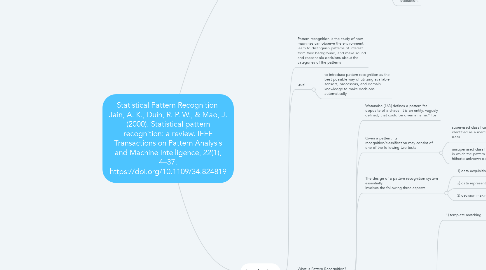
1. Abstract
1.1. Objective
1.1.1. to summarize and compare some of the well-known methods used in various stages of a pattern recognition system
1.1.2. identify research topics and applications which are at the forefront of this exciting and challenging field.
1.2. Issues of PR design
1.2.1. definition of pattern classes
1.2.2. sensing environment, pattern
1.2.3. pattern representation,
1.2.4. feature extraction and selection
1.2.5. classifier design and learning
1.2.6. selection of training and test samples
1.2.7. evaluation.
2. Intoduction
2.1. Pattern recognition is the study of how machines can observe the environment, learn to distinguish patterns of interest from their background, and make sound and reasonable decisions about the categories of the patterns
2.2. goal
2.2.1. to introduce pattern recognition as the best possible way of utilizing available sensors, processors, and domain knowledge to make decisions automatically.
2.3. What is Pattern Recognition?
2.3.1. Watanabe [163] defines a pattern ªas opposite of a chaos; it is an entity, vaguely defined, that could be given a name.º For
2.3.2. Given a pattern, its recognition/classification may consist of one of the following two tasks
2.3.2.1. supervised classification :input pattern is identified as a member of a predefined class
2.3.2.2. unsupervised classification (e.g., clustering) in which the pattern is assigned to a hitherto unknown class. Note
2.3.3. The design of a pattern recognition system essentially involves the following three aspects:
2.3.3.1. 1) data acquisition and preprocessing)
2.3.3.2. 2) data representation
2.3.3.3. 3) decision making.
2.3.4. The four best known approaches for pattern recognition:
2.3.4.1. 1) template matching
2.3.4.1.1. Matching is a generic operation in pattern recognition which is used to determine the similarity between two entities (points, curves, or shapes) of the same type.
2.3.4.2. 2) statistical classification
2.3.4.2.1. each pattern is represented in terms of d features or measurements and is viewed as a point in a d-dimensional space
2.3.4.2.2. The goal is to choose those features that allow pattern vectors belonging to different categories to occupy compact and disjoint regions in a d-dimensional feature space. The
2.3.4.2.3. The effectiveness of the representation space (feature set) is determined by how well patterns from different classes can be separated. Given
2.3.4.2.4. Approach
2.3.4.3. 3) syntactic or struc- tural matching,
2.3.4.3.1. involving comples pattern
2.3.4.3.2. the ªbestº decision boundary of the specified form is found based on the classification of training patterns
2.3.4.4. 4) neural networks
2.3.4.4.1. Neural networks can be viewed as massively parallel computing systems consisting of an extremely large number of simple processors with many interconnections
2.4. statistical approach and can be broadly categorized into the following subtopics: curse
2.4.1. curse of dimensionality (15)
2.4.2. dimen- sionality reduction (50)
2.4.3. classifier design (175)
2.4.4. classifier combination (10)
2.4.5. error estimation (25) and
2.4.6. unsupervised classification (50)
